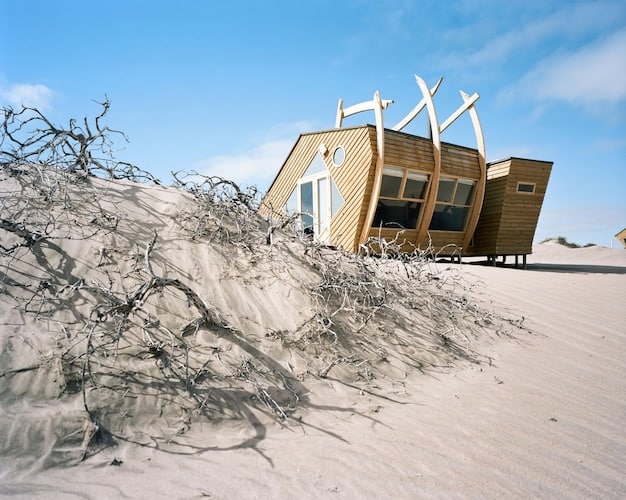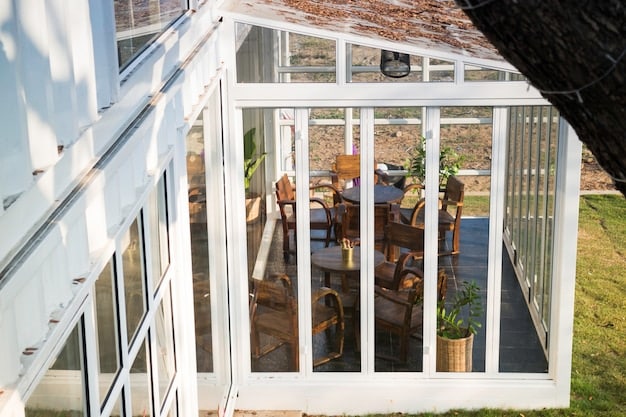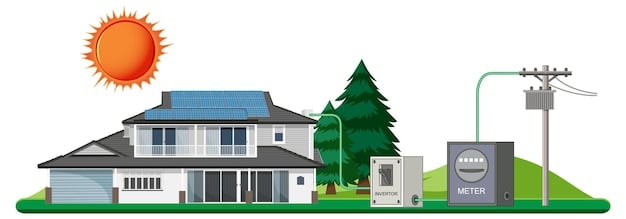Build Disaster-Resistant Home: Ultimate Protection from Extreme Weather

Building a disaster-resistant home involves strategic planning, robust construction techniques, and advanced material selection to significantly enhance a property’s resilience against the increasing threats posed by extreme weather events, safeguarding both property and inhabitants.
In an era marked by increasingly severe and unpredictable weather patterns, the concept of a resilient home has transitioned from a niche concern to a mainstream necessity. Understanding how to build a disaster-resistant home: protecting your investment from extreme weather is not just about safeguarding property; it’s about securing peace of mind and the well-being of those within its walls.
Understanding the Evolving Threat of Extreme Weather
The climate is changing, and with it, the frequency and intensity of extreme weather events are escalating. From devastating hurricanes and tornadoes to unprecedented wildfires and prolonged droughts, these phenomena pose significant threats to infrastructure, communities, and individual homes. Recognizing the specific risks your region faces is the crucial first step in building a truly resilient structure.
Historically, residential construction practices were largely based on localized, anecdotal knowledge of weather patterns. However, the current climate reality demands a more scientific, forward-looking approach. Homeowners, builders, and policymakers alike must acknowledge that what was once considered an “uncommon” weather event could soon become the new norm.
This evolving threat necessitates a paradigm shift in how we conceive, design, and construct our homes. It’s no longer sufficient to build to minimum code requirements; a proactive stance that anticipates worst-case scenarios is becoming increasingly vital. The goal isn’t just to repair after a disaster, but to withstand it, mitigating damage and ensuring rapid recovery. This involves a comprehensive understanding of specific meteorological threats and their potential impact on various building components.
The economic repercussions of extreme weather events are staggering, not only in terms of property damage but also business interruption, displacement, and loss of life. Investing in disaster-resistant construction upfront can yield substantial long-term savings by reducing the need for costly repairs, insurance claims, and temporary housing. Furthermore, such homes often command a higher market value due to their enhanced safety features and durability.
Ultimately, understanding the evolving threat means acknowledging our vulnerability and taking decisive action. It’s about more than just personal safety; it’s about contributing to community resilience and fostering a sustainable future where homes are built to endure the challenges of a changing climate.
Foundational Strength: Anchoring Against the Elements
The foundation is literally the bedrock of a home’s resilience. Without a strong, properly anchored foundation, even the most robust superstructure can be vulnerable to extreme forces like high winds, seismic activity, or flooding. The choice of foundation type and its connection to the overall structure are paramount for disaster resistance.
For areas prone to hurricanes and high winds, poured concrete slabs or elevated pier-and-beam foundations anchored deep into the ground are often preferred. These foundations reduce the surface area exposed to rising floodwaters or storm surges. Proper drainage around the foundation is also critical to prevent water intrusion and soil erosion, which can undermine its stability.
Reinforcing Concrete and Connections
The strength of a concrete foundation lies not only in its thickness but also in its internal reinforcement and its connection to the framing above. Steel rebar and fiber mesh are commonly used to increase tensile strength and prevent cracking under stress. Anchor bolts, straps, and hurricane clips are vital for securely connecting the walls to the foundation, preventing the house from lifting off during severe wind events.
- Steel Rebar: Increases the concrete’s ability to withstand pulling forces.
- Anchor Bolts: Directly connect wall plates to the foundation slab.
- Hurricane Clips: Securely fasten the roof to the walls and walls to the foundation, creating a continuous load path.
- Waterproofing Membranes: Protect the foundation from moisture penetration, preventing structural damage and mold growth.
In seismic zones, foundations must be designed to absorb and distribute shockwaves. This often involves larger footings, more extensive rebar grids, and flexible connection systems that allow for some movement without catastrophic failure. Shear walls, designed to resist lateral forces, are also integrated into the foundation system to enhance stability.
Elevated foundations, particularly in flood-prone areas, offer significant protection. Elevating the main living space above the projected flood level (base flood elevation, or BFE) can prevent floodwaters from reaching critical components. This often involves sturdy concrete piers, pilings, or an elevated crawl space designed to allow water to pass through without causing structural damage.
Ultimately, a robust foundation is an unsung hero in disaster-resistant construction. It’s the essential first step that dictates the overall integrity of the home. Future-proofing your home begins literally from the ground up, ensuring that the critical connection between the house and the earth it stands upon is engineered for maximum resilience against whatever nature might unleash.
Building Envelopes: Protecting Against Wind, Water, and Fire
The building envelope – comprising the roof, walls, windows, and doors – is the primary line of defense against external threats. Its integrity is crucial for resisting direct impacts, wind penetration, water infiltration, and even fire spread. Strategic choices in materials and construction techniques for the envelope significantly enhance a home’s ability to withstand extreme weather.
For roofs, impact-resistant shingles or metal roofing are superior to standard asphalt in resisting hail and high winds. Secure fastening systems are critical to prevent uplift. Walls constructed with reinforced concrete, insulated concrete forms (ICFs), or advanced framing techniques using continuous sheathing provide higher resistance to wind-borne debris and offer improved insulation.
Windows and Doors: Vulnerable but Fortifiable
Windows and doors are often the weakest links in a home’s envelope during extreme weather. High-impact-resistant windows, often made with laminated glass, can withstand direct impacts from debris without shattering. When these windows are combined with robust, secure frames, they maintain the building’s pressure envelope, preventing catastrophic internal pressure differentials during high winds.
- Impact-Resistant Windows: Laminated glass, often with a PVB interlayer, to prevent shattering.
- Reinforced Entry Doors: Solid core doors with multiple locking points and robust frames.
- Garage Doors: Specialized bracing and track systems to resist wind pressure and suction.
- Exterior Shutters: Permanently installed, easily deployable shutters provide an extra layer of protection for windows and glass doors.

For fire resistance, especially in wildfire-prone areas, consider non-combustible materials for siding, such as fiber cement, stucco, or masonry. Roof materials like metal or clay tiles offer excellent fire resistance. Creating a defensible space around the home by managing vegetation and removing combustible materials is equally vital.
Water infiltration is a pervasive problem after severe weather. Proper flashing around windows, doors, and roof penetrations is essential. Water-resistant barriers beneath siding and robust drainage planes ensure that any water that penetrates the outer layer is directed away from the interior. Sealing all exterior joints and cracks with high-quality caulk further prevents moisture intrusion.
The building envelope is a complex system, and its resilience depends on the weakest component. Therefore, a holistic approach to material selection and installation is paramount. Each element – from the smallest fastener to the largest wall panel – contributes to the overall strength and durability of the home against the forces of nature.
Strategic Landscaping and Site Design: Beyond the Structure
A disaster-resistant home isn’t only about the structure itself; the surrounding landscape and site design play a crucial role in mitigating risks. Thoughtful planning of vegetation, drainage, and topography can significantly enhance a property’s resilience against flooding, wildfires, and even wind damage. This holistic approach integrates the home seamlessly into its environment while minimizing vulnerabilities.
For properties in wildfire-prone areas, creating a “defensible space” is paramount. This involves carefully managing vegetation around the home, clearing combustible materials, and selecting fire-resistant plant species. The defensible space typically extends in concentric zones from the house, with stricter fuel reduction requirements closer to the structure.
Managing Water Flow and Erosion
Effective water management is critical in areas susceptible to heavy rainfall and flooding. Proper grading around the home should direct water away from the foundation. Installing permeable paving, swales, and rain gardens can help absorb and slow down stormwater runoff, reducing the burden on municipal drainage systems and preventing localized flooding and erosion.
- Fire-Resistant Landscaping: Choosing drought-tolerant, low-flammability plants and maintaining clear zones.
- Strategic Tree Placement: Planting trees away from the house to prevent falling debris during high winds.
- Erosion Control: Installing retaining walls or terracing on slopes to stabilize soil.
- Permeable Surfaces: Utilizing gravel, pavers, or porous concrete instead of impermeable asphalt to facilitate water absorption.
In hurricane and high-wind zones, strategic tree placement is vital. Trees that are too close to the house, especially large deciduous trees, can become projectiles during severe storms. Regular maintenance, including trimming dead or weak branches, can reduce this risk. Conversely, a well-planned windbreak of dense, resilient trees positioned upwind can help deflect and reduce wind forces on the home.
Site design also considers the property’s elevation relative to its surroundings. If building on a slope, techniques like terracing and proper drainage are essential to prevent landslides and erosion. For homes near coastlines or floodplains, understanding historic flood levels and planning for future sea-level rise or increased precipitation is crucial when setting the home’s finished floor elevation.
Ultimately, strategic landscaping and site design are integral components of a comprehensive disaster resilience strategy. They act as a natural buffer, working in harmony with the hardened structure to create a layered defense against the escalating threats of extreme weather. This foresight in planning saves significant resources and stress in the long run.
Utility and System Resilience: Keeping the Lights On and Water Flowing
While structural integrity is paramount, a truly disaster-resistant home also focuses on the resilience of its utility systems. Power outages, water contamination, and gas line ruptures are common consequences of extreme weather, rendering even an undamaged home uninhabitable. Ensuring that essential services remain functional or can be quickly restored is a key aspect of preparedness and resilience.
For electrical systems, burying power lines where feasible can protect them from wind-borne debris and falling trees. Installing a reliable backup power source, such as a whole-house generator, can provide continuous electricity during extended outages. These generators can be fueled by natural gas, propane, or even solar power with battery storage, offering varying degrees of independence from the grid.
Protecting Water and Gas Systems
Water systems are particularly vulnerable to freezing, contamination, and disruption. Insulating pipes in unconditioned spaces can prevent freezing and bursting during cold snaps. For well water systems, securing the wellhead against floodwaters and having a backup power source for the pump are essential. Installing a water purification system can provide potable water if the municipal supply is compromised.
- Whole-House Generator: Automatic transfer switch for seamless power during outages.
- Solar Panels with Battery Storage: Provides clean, sustainable backup power and reduces reliance on the grid.
- Propane Tanks: Securely anchored above flood levels and protected from impacts.
- Water Shut-off Valves: Easily accessible main shut-off valve to prevent extensive water damage from burst pipes.

Gas lines, whether natural gas or propane, pose specific risks. Ensuring that outdoor propane tanks are securely anchored and protected from impacts is vital. For natural gas lines, homeowners should know how to shut off the gas supply at the meter in case of a leak or rupture, though this should only be done if safe to do so. Automatic shut-off valves for gas are also available.
Furthermore, homes can integrate smart technologies that monitor utility usage and provide alerts for potential issues like pipe leaks or power fluctuations. These systems can also control smart appliances or turn off non-essential loads during an outage to conserve power, making the home’s systems more efficient and resilient.
Ultimately, utility and system resilience is about maintaining habitability. An undamaged house without power or water is just a shell. By investing in robust, redundant, and protected utility systems, homeowners can ensure their property remains a safe and functional sanctuary even when the external world is in disarray, facilitating a quicker return to normalcy after a disaster.
Interior Preparedness and Safety Measures: Beyond Structural Defense
While structural fortification is essential, a truly disaster-resistant home also incorporates interior preparedness and safety measures that enhance habitability, protect occupants, and facilitate recovery. These elements focus on what happens inside the house during and after an extreme event, ensuring that the occupants are safe, informed, and capable of responding effectively.
First and foremost is ensuring a safe room or designated shelter area within the home, especially in tornado or hurricane-prone regions. This room, often reinforced with concrete and steel, should be capable of withstanding extreme forces, providing a secure refuge for occupants during the most intense phases of a storm. It should be stocked with emergency supplies, communication devices, and first-aid kits.
Emergency Supplies and Communication
Every disaster-resistant home should have a comprehensive emergency kit, readily accessible. This kit should include enough food and water for at least 72 hours per person, medications, flashlights, a battery-powered or hand-crank radio, and essential documents. Communication plans, including designated meeting points and out-of-state contacts, are crucial for family reunification.
- Emergency Kit: Non-perishable food, water, first-aid, medications, and tools.
- Designated Safe Room: Interior room or basement reinforced for protection from high winds and debris.
- Smoke Detectors and CO Alarms: Essential for fire safety and carbon monoxide detection, especially if generators are in use.
- Secure Heavy Furniture: Anchoring bookshelves, televisions, and other heavy items to walls to prevent tipping during seismic events or high winds.
For homes in flood plains, elevating critical appliances like furnaces, water heaters, and electrical panels above potential flood levels is a smart preventive measure. Having floor drains with backflow preventers can stop sewer backups during heavy rains. Storing valuable items and important documents on upper floors or in waterproof containers is also advisable.
Furthermore, establishing fire evacuation routes and practicing drills can significantly improve safety. For homes in wildfire interface zones, having an easily accessible ladder for roof access and maintaining a clear perimeter is important. Installing smart home systems that can monitor for gas leaks, water leaks, or unusual thermal shifts can provide early warnings, allowing for proactive intervention.
Interior preparedness extends beyond physical items; it encompasses knowledge and readiness. Understanding how to shut off utilities, knowing evacuation routes, and having a family communication plan are intangible yet invaluable assets. A truly resilient home considers not just the exterior shell but the entire ecosystem of safety, comfort, and informed action within its walls.
Insurance and Financial Planning: The Last Line of Defense
Building a physically disaster-resistant home is a significant investment. Equally important, however, is the financial preparedness to complement this physical resilience. Adequate insurance coverage and strategic financial planning serve as the final but critical line of defense, mitigating the economic shocks that can follow even a minor disaster.
Standard homeowner’s insurance often does not cover all perils. Flood insurance, for instance, is typically separate and essential for homes in flood zones, as well as highly recommended even outside designated zones, given changing weather patterns. Similarly, earthquake insurance is a distinct policy that homeowners in seismic areas should consider. Reviewing policies annually to ensure adequate coverage for rebuilding costs, personal property, and living expenses during displacement is crucial.
Understanding Coverage and Deductibles
It’s important to understand the specifics of your coverage, including deductibles, policy limits, and exclusions. Some policies may have separate, higher deductibles for wind or hail damage. Being aware of these details avoids unpleasant surprises when a claim needs to be filed. Documenting your home’s contents through detailed inventories and photographs can significantly streamline the claims process.
- Comprehensive Insurance Review: Assessing standard, flood, and earthquake policies.
- Rebuilding Cost Assessment: Ensuring coverage aligns with current construction costs in your area.
- Emergency Fund: Maintaining a readily accessible fund for immediate post-disaster needs not covered by insurance.
- Professional Consultations: Seeking advice from insurance agents specializing in disaster coverage and financial planners for long-term strategies.
Beyond insurance, creating an emergency fund is vital. This fund can cover immediate expenses not reimbursed by insurance, such as temporary lodging, essential supplies, and minor repairs that allow for faster recovery. Having access to liquid assets provides flexibility and reduces stress during a chaotic time.
Furthermore, many states and federal programs offer incentives or grants for homeowners who invest in disaster mitigation improvements. These can include tax credits for upgrades like reinforced roofs or impact-resistant windows, or grants for elevating homes in flood zones. Researching these opportunities can make disaster-resistant upgrades more financially feasible.
Finally, maintaining copies of essential documents – insurance policies, property deeds, financial records, and medical information – in a secure, off-site location or digitally in a cloud-based service ensures they are accessible even if the physical home is damaged. This foresight simplifies recovery and administrative tasks when facing the aftermath of an extreme weather event.
In essence, financial planning and robust insurance are not just about recovering losses; they are about maintaining stability and peace of mind during and after a crisis. They complete the cycle of resilience, ensuring that your investment and your life can rebound effectively when confronted with the unpredictable forces of nature.
| Key Aspect | Brief Description |
|---|---|
| 🏗️ Structural Integrity | Reinforced foundations, walls, and roofs designed to withstand extreme forces. |
| 🛡️ Building Envelope | Impact-resistant windows/doors and fire-resistant siding/roofing. |
| 🌲 Site Resilience | Strategic landscaping, proper drainage, and defensible space for wildfire protection. |
| 💡 Utility Security | Backup power, secured water systems, and protected gas lines. |
Frequently Asked Questions
▼
The most effective method involves using a combination of impact-resistant roofing materials, such as metal or heavy asphalt shingles, installed with enhanced fastening techniques. This includes using six fasteners per shingle instead of four, and ensuring that the roof decking is securely attached to the trusses or rafters with hurricane clips or strong anchors. Proper attic ventilation also helps reduce pressure differentials.
▼
Yes, impact-resistant windows are generally considered well worth the extra investment, especially in hurricane or tornado-prone regions. They prevent wind-borne debris from breaching the home’s envelope, which can lead to catastrophic internal pressure changes and structural failure. Beyond storm protection, they also offer enhanced security, noise reduction, and improved energy efficiency due to their robust construction.
▼
Defensible space is critically important for wildfire protection. It involves creating a zone around your home where vegetation and other combustible materials are managed to reduce fire intensity and slow its spread, giving firefighters a safer area to work. This proactive measure significantly increases the likelihood of your home surviving a wildfire, acting as a crucial buffer against advancing flames and embers.
▼
For flood-prone areas, elevated foundations are generally the best. This includes pilings, piers, or an elevated crawl space, raising the lowest floor above the Base Flood Elevation (BFE). This allows floodwaters to flow beneath the structure without causing significant damage to the main living areas. Proper flood vents in crawl spaces are also essential to balance hydrostatic pressure.
▼
Yes, smart home technology can significantly enhance disaster resistance. Systems can alert homeowners to potential threats like water leaks, abnormal temperature changes (indicating freezing pipes), or unexpected power outages. Smart grids can optimize energy use during backup power scenarios, and remote monitoring allows homeowners to check on their property from afar, facilitating quicker response in an emergency.
Conclusion
In a world grappling with escalating climate volatility, the pursuit of a disaster-resistant home has become a profound act of foresight and responsibility. It transcends mere construction; it is an integrated strategy encompassing robust foundations, resilient building envelopes, intelligent site design, fortified utility systems, and comprehensive interior and financial preparedness. Embracing these principles transforms a house from a vulnerable structure into a guardian of safety and an enduring asset. The investment in such resilience ultimately safeguards not only material possessions but also the peace of mind and well-being of those who call it home, providing a powerful answer to the unpredictable forces of nature.





